MANY STITCHES FOR LIFE:
THE ANTIQUITY OF THREAD AND NEEDLE TATTOOING
| |
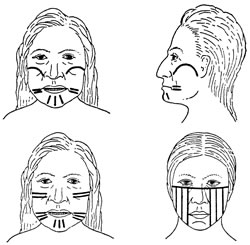
 |
| |
Facial and body tattoos of the Thompson River Salish (Nlaka'pamux), British Columbia, Canada, 1910. |
Article © 2008 Lars Krutak
For thousands of years, indigenous
peoples around the world marked their bodies
with skin-stitched tattoos. This painful
form of body art was not just the latest
fashion, it was a visual language that
exposed an individual's desires and fears as
well as ancient cultural values and
ancestral ties that were written on the
body.
Although some of these tattoos did hold an iconic allure, others were
believed to have had magical power and purpose. For example, three
vertical bands tattooed on the cheeks of St. Lawrence Island, Alaska
women were thought to induce fertility, while other configurations of
markings were believed to protect them from unseen enemies or illnesses
borne from evil spirits. Still more designs were thought to attract prey
animals and even men. The Thompson River Salish (Nlaka'pamux) of Canada
also tattooed for ornamental purposes, but they sometimes inscribed
their bodies with thread and needle to show courage, to acquire
strength, to or to display enduring fidelity and love in marriage. The
Nlaka'pamux also marked their bodies to ward off death and sickness or
to acquire a guardian spirit.
Sadly, however, skin-stitched tattooing has largely disappeared in
the world along with its practitioners. In Canada, only one Inuit woman
living on King William Island retains her elaborate facial and body
tattoos. And to date, just a handful of Siberian Yupik and Chukchi women
in Siberia continue to wear similar indelible markings.
Tattooing in the Arctic
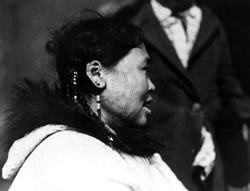
St. Lawrence Island
Yupik woman with facial tattoos.
Photograph © 1997 Lars Krutak.
|
|
By far skin-stitched
tattoos were most popular among the
indigenous peoples of the Arctic. In
fact, this style of tattooing was
practiced for over 2,000 years and
was most common among women. As a
general rule, expert tattoo artists
were respected elderly women. Their
extensive training as skin
seamstresses (parkas, pants, boots,
hide boat covers, etc.) facilitated
the need for precision when
stitching the human skin with
tattoos.
Tattoo designs were usually made
freehand but in some instances a
rough outline was first sketched
upon the face, arms, hands, and
other body parts that were to be
tattooed. On St. Lawrence Island,
the tattoo pigment was made from the
soot (aallneq) of seal oil lamps
which was taken from the bottom of
tea kettles or similar containers
used to boil meat or other foods.
The soot was mixed with urine (tequq),
often that of an old woman, and
sometimes graphite (tagneghli) or
seal oil was added. Next, a sinew (ivalu)
thread from a reindeer was drawn
through the eye of a needle and
dipped into the coloring substance.
This thread was then inserted just
under the skin for a distance of
about a 1/32 of an inch and after
several stitches tiny dots began to
form lines and other desired motifs.
Tattooing needles were traditionally
made from slivers of bone, but as
time passed St. Lawrence Islanders (Sivuqaghhmiit)
began using steel needles for
skin-stitching. According to one of
the last tattooed elders, a very
small bag of seal intestine was used
to hold the tattoo needle: "they
don't use this needle for anything
else, they just keep it in there and
nobody else is supposed to touch it
except the one who used it." Of
course, when anyone was injured
either accidentally or willfully by
the needle, it was not used again
until the wound had healed. If
sickness resulted on account of such
an injury or if death occurred, the
needle was taken with the body of
the dead or it was destroyed.
Although ornamental and family
designs were applied to most parts
of the body (e.g., face, arms, torso
and hands), medicinal tattoos akin
to acupuncture were placed on
particular joints. Of course, the
Sivuqaghhmiit were not the only
indigenous people to sport such
markings. The 5,000-year-old Iceman
wore similar medicinal tattoos at
rheumatic joints as did members of
the nomadic Pazyryk people who ruled
the Siberian steppes some 2,500
years ago. The Unangan and Alutiiq
of the Aleutian Islands also
utilized this medicinal treatment. |
|
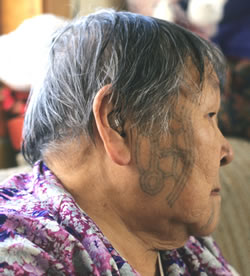
Flora Imergan (Elqiilaq), who died in 2000, was one of the last completely tattooed women of St. Lawrence Island, Alaska. All of Elqillaq's facial tattoos date from the 1920s, and consist of fertility markings and other motifs near the ear called qilak or "heavens."
Photograph © 1997 Lars Krutak.
|
|
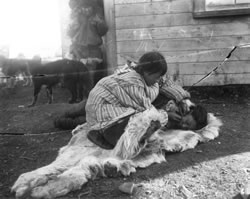
Siberian Yupik woman "stitching the skin" at Indian Point, Chukotka, 1901. Photograph by Waldemar Bogoras.
Siberian and St. Lawrence Island
Yupik girls became women after
receiving their first skin-stitched
tattoos at the onset of puberty.
Women who could not endure the
painful skin-stitching were
ridiculed by their peers, and
sometimes they had difficulty in
finding a husband. Today, only a
handful of Siberian Yupik and Chukchi women possess these
markings. Sadly, the tradition is
now extinct on St. Lawrence Island. |
|
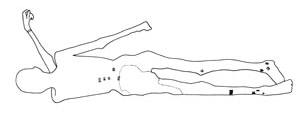
The 5,000-year-old Iceman. Small lines of therapeutic tattooing have been found on his rheumatic joints, and 80% of the Iceman's tattoos correspond to actual acupuncture points. Interestingly, archaeological evidence indicates that the earliest form of tattooing was not medicinal but rather cosmetic. And around 8,000 years ago, at least one man of the Chile was tattooed with what looks like a small mustache on his upper lip. It is believed that this tattoo was pricked-in rather than sewn.
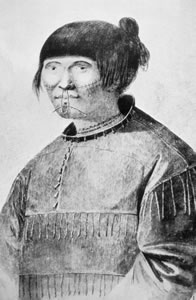
Tattooed Unangan woman of Unalaska
Island, Alaska, 1778. Drawing by
John Webber.
Although the peoples of the Aleutian
Islands used medicinal tattooing for
complaints in their joints, the
Russian priest Veniaminov wrote
around 1830 that Unangan women from
Unalaska Island (Alaska) wore
skin-stitched tattoos across their
faces and bodies because, "the
pretty ones and also the daughters
of famous and rich ancestors and
fathers, endeavored in their
tattooings to show the
accomplishments of their
progenitors, as for instance, how
many enemies, or powerful animals,
that ancestor killed."
|
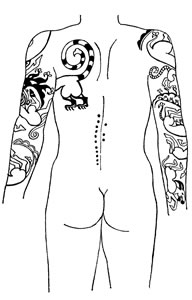
Above:
Pazyryk chief with medicinal
dot-tattooing & elaborate zoomorphic body tattooing, 500 B.C. |
Chimú
The Chimú of Pre-Columbian Peru applied
tattoo pigments with various types of
needles (fishbone, parrot quill, spiny
conch) which have been found in mummy
burials. The technical application of
tattooing was a form of skin-stitching, and
it has been suggested that women were the
primary tattoo artists.
Paleopathological studies of Chimú mummies
(1100-1470 A.D.) indicate that the practice
of tattooing was quite common among both
males and females. In some coastal
settlements, it has been estimated that at
least thirty percent of the population may
have been tattooed.
Interestingly, the Chimú seemed to have used
the juices of the genipap (genipa americana
L.) as tattoo pigment. Juices of the green,
immature fruits of the genipap have and
continue to be used as black body paint and
tattoo pigment by historic and contemporary
indigenes of South America. Among some
groups, the coloring substance was highly
esteemed because it was believed to repel
incorporeal spirits. This was especially
true of the headhunting Jívaro and Mundurucú
who painted themselves and their
trophy
heads with genipap to protect the victor
from the spirit of the deceased.
|
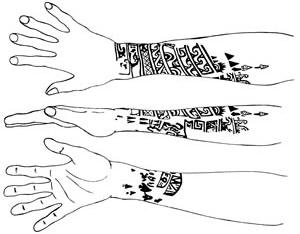 |
|
Chimú mummies with naturalistic and
geometric tattooing, 1200 A.D.
Drawing courtesy of Dr. Marvin
Allison.
Hidden in shifting sands along the
coastal valleys of Peru, mummies of
the Chimú culture have been
discovered bearing intricate tattoos
of animals, weapons, landscape
features, and anthropomorphic
deities. Similar designs were
engraved into wood, silver, and
hammered gold burial gloves. Tattoos
of the sacred dead perhaps served as
magical mediators between this world
and the next by carrying the body
into the afterlife. |
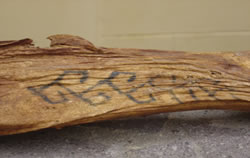
According to
pathologist Dr. Marvin J.
Allison, the leg tattoos of this
recently excavated Tiwanaku
mummy (1000 A.D.) from Peru were
stitched-in with needle and
thread. Photograph © 2005 Marvin
J. Allison.
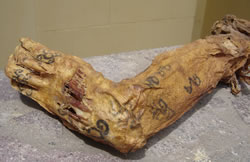
Tiwanaku culture mummy with skin-stitched avian tattoos on the forearm and other designs, possibly spiders, on the knuckles, 1000 A.D. Photograph © 2005 Marvin J. Allison.
|
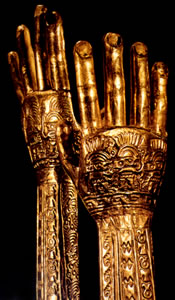
Above:
Chimú burial gloves of hammered gold
with tattoo designs, 1200-1300 A.D.
Collection of the
Museo Oro del Perú. |
Many Stitches for Life
Skin-stitched tattoos firmly anchored
indigenous values on the skin by creating a
visual mosaic rooted in traditional
practice. These tattoos not only satisfied
the need for display and personal
accomplishment; they also embodied religious
beliefs about the relationships between
humans, animals, spirits, and the ancestors
who controlled human destiny and the
surrounding world. Thus, as a system of
tools and techniques by which indigenous
people used to relate to their environment,
community, and culture, skin-stitched
tattooing expressed the many ways in which
indigenous people attempted to control their
bodies, lives, and experiences.
Museum photo gallery of these images may
be seen here.
Literature
Allison, J. Marvin, Lawrence Lindberg,
Calogero Santoro, and Guillermo Foracci.
(1981). "Tatuajes Y Pintura Corporal de Los
Indigenas Precolumbinos de Peru Y Chile."
Chungara 7: 218-225.
Karsten, Rafael. (1926). Civilization of the South American Indians:
With Special Reference to Magic and Religion. London: Kegan Paul.
Rudenko, Sergei I. (1970). Frozen Tombs of Siberia; The Pazyryk
Burials of Iron Age Horsemen. Berkeley: University of California Press.
Teit, James A. (1930). "Tattooing and Face and Body Painting of the
Thompson Indians, British Columbia." Pp. 397-439 in 45th Annual Report
of the Bureau of American Ethnology. Washington: U.S. Government
Printing Office.
Veniaminov, Ivan E.P. (comp.). (1840). Zapiski ob ostrovakh
Unalashkinskago otdiela [Notes on the Islands of the Unalaska District].
3 vols. in 2. St. Petersburg: Russian-American Company. |












